January 03, 2011 – 05:45 am EST
Welcome to twenty eleven and thanks for joining us for the ride. I know I have really enjoyed connecting with many of you over the last year and hope that you all get value from the ideas that we share. There is a heap of research to get through and I hope to put more time into ETF HQ this year. Let us know if there are any particular areas that you would like us to focus on.
To the markets – it was yet another uneventful week that basically finished where it started. However periods of consolidation are nearly always followed by sudden breakouts and such a breakout now appears imminent.
.
*****Happy New Year!! Thanks for keeping this service growing my spreading the word.
.
ETF % Change Comparison
.

It is positive to see the transports (IYT) closing the week at a new high but the market has been mostly flat as you can see.
.
Learn more – ETF % Change Comparison
.
![]()
.
A Look at the Charts
.
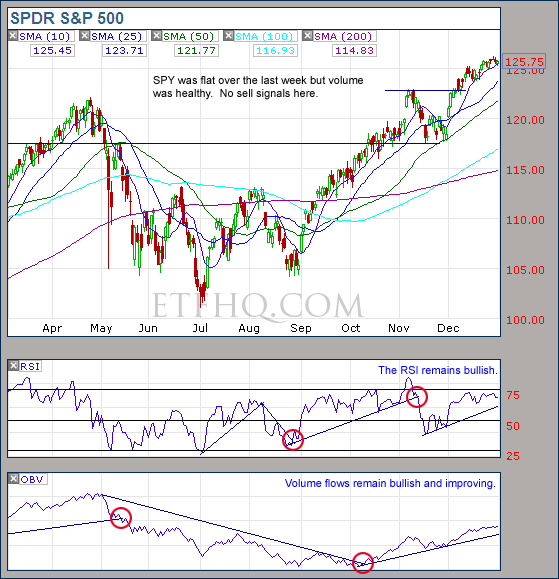
SPY made no ground over the last week but volume flows continue to improve.
.
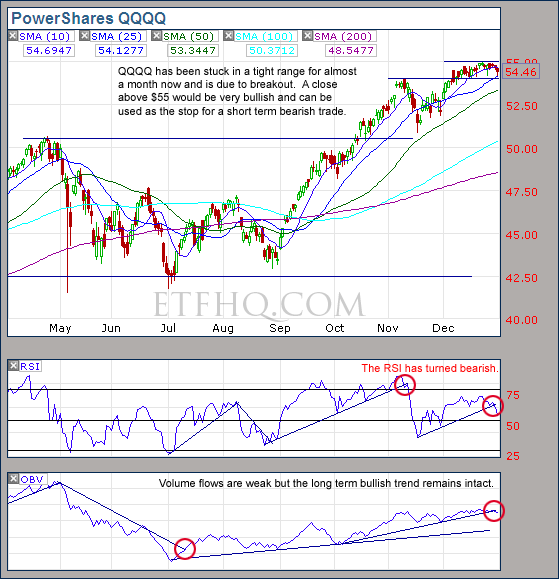
Support from the Nov high and resistance at $55, expect a breakout very soon.
.
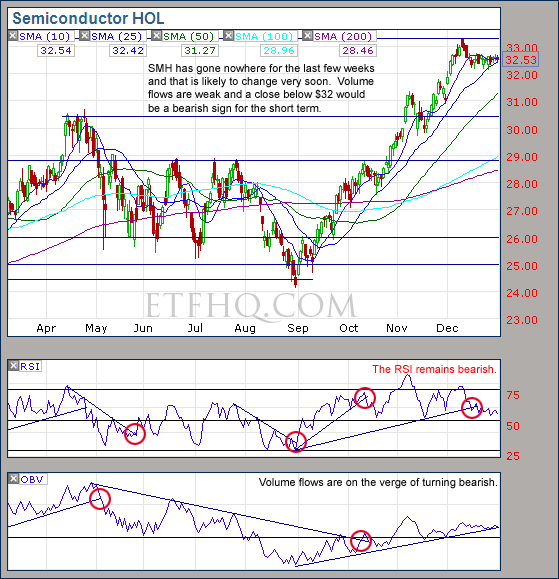
A close below $32 would weigh heavily on the broad market.
.
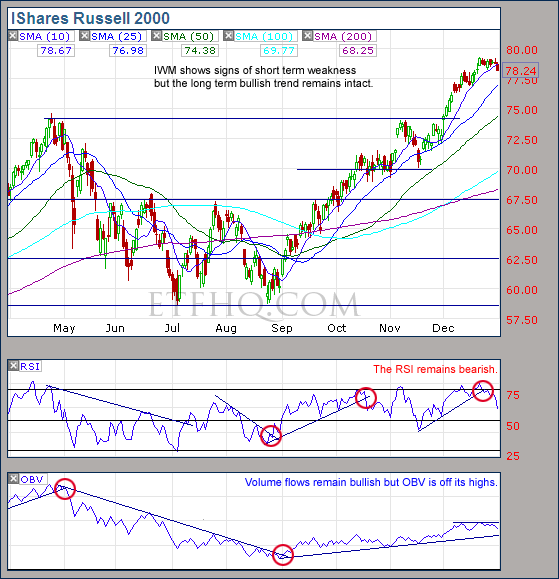
No indications of a rally over the short term from IWM.
.
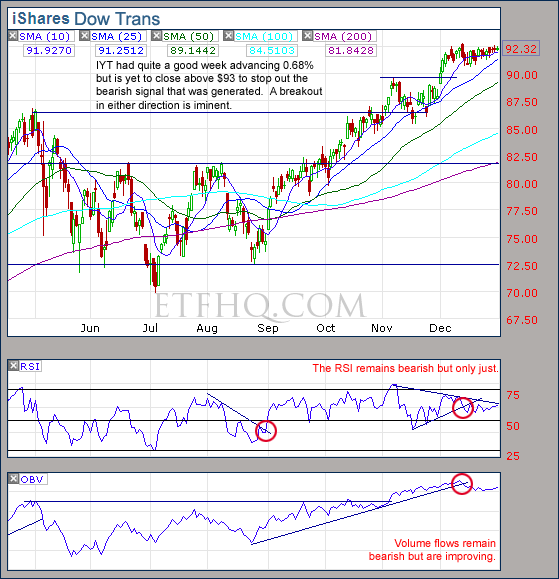
Volume on IYT is improving, the stop at $93 is likely to be hit this week if this trade fails.
.
![]()
.
OM3 Weekly Indicator
.

Buy signals remain active across the board while the ‘Bear Alerts’ continue to show that the weekly cycle is weakening.
Learn more – The OM3 Indicator
.
![]()
.
TransDow & NasDow
.

The Transports remain dominant over the Dow and the TransDow trade is showing a profit of 10.34% after 84 days. The NasDow remains in cash as the Dow remains dominant over the NASDAQ.
.
What the TransDow Readings tell us:
The TransDow measures dominance between the DJ Transportation Index (DJTI) and the Dow Jones Industrial Average (DJIA). In a strong market the more economically sensitive Transportation Index should be dominant over the DJIA.
Historically the DJTI has been dominant over the Dow 45% of the time. The annualized rate of return from the DJTI during this period was 18.47% with the biggest loss for one trade sitting at -13.27%. The annualized return from the DJIA during the periods it was dominant over the DJTI was just 4.06% and the biggest loss for one trade was -16.13%. A 4% stop-loss is applied to all trades adjusting positions only at the end of the week.
What the NasDow Readings tell us:
The NasDow measures dominance between the NASDAQ and the DJIA. Using the same theory behind the Trans Dow; in a strong market the more economically sensitive NASDAQ should be dominant over the DJIA.
Historically the NASDAQ has been dominant over the DJIA 44% of the time. Taking only the trades when the NASDAQ is above its 40 week moving average the annualized rate of return was 25.47% with the biggest loss for one trade sitting at –8.59%. The annualized rate on the DJIA during the periods it was dominant over the NASDAQ is just 8.88% and the biggest loss for one trade was –12.28%. A 8% stop-loss is applied to all trades adjusting positions only at the end of the week.
.
![]()
.
LTMF 80 & Liquid Q
.
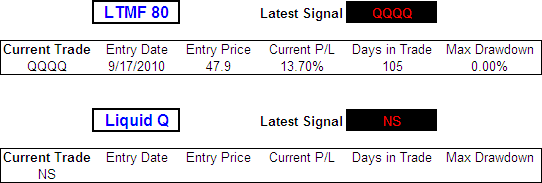
The LTMF 80 continues to hold a position in QQQQ that is currently showing a profit of 13.70%. Liquid Q remains in cash.
.
Historical Stats:
.

.
How The LTMF 80 Works
LTMF stands for Long Term Market Forecaster. It reads volume flows relative to price action and looks for out performance of volume measured on a percentage basis over the prior 12 months. During a sustained rally the readings will reach high levels (near 100%) making it imposable for the volume reading to always outperform price so any reading above 80% will maintain the buy signal. This system has outperformed the market over the last 10 years but performance has been damaged by some nasty losses. It only produces buy signals and only for QQQQ.
How Liquid Q Works
Liquid Q completely ignores price action and instead measures the relative flow of money between a selection of economically sensitive and comparatively stable ares of the market. It looks for times when the smart money is confident and and can be seen by through volume investing heavily is more risky areas due to an expectation of expansion. This system has outperformed the market over the last 10 years and remained in cash through most of the major declines. It only produces buy signals and only for QQQQ. We will provide more performance details on the web site for these systems soon.
.
![]()
.
Summary
The consolidation over the last month has been within a tight range that has created support underfoot and resistance overhead. There appears to be little indication that the breakout will be bullish but we are also lacking many sell signals at this point. A close by QQQQ above $55 and IYT above $93 would be very bullish and likely mark the start of another leg to this rally. Until then the risk remains to the downside.
Any disputes, questions, queries, comments or theories are most welcome in the comments section below.
.
Cheers
Derry
And the Team @ ETF HQ
“Equipping you to win on Wall St so that you can reach your financial goals.”
.
![]()
.
Quote of the Day:
“Millions saw the apple fall, but Newton was the one who asked why.” – Bernard M. Baruch
Derry,
Are you aware of the intra day high of 55.07 that was struck on October 31, 2007? For the past 12 trading days the QQQQ has stopped just below that line in the sand and has not been able to breach that level…… This could be a significant turning point in this hollow, fraudulent, government induced rally….. If so, the panic that could occur on the next down move could be significant.
Mike
Or a breakout toward the up-side could take place, followed by a sustained rally. In which case the “conspiracy theorists” are left behind looking foolish, as usual.
Now that QQQQ is at $55.5 and has pierced this $55.07 resistance convincingly. So is this an upside breakout or just a fake-out? Also AAPL now has a 20% weighing in QQQQ, so how would that skew this and Derry’s predictions?
The following is from Powershares on QQQQ:
“The Index includes 100 of the largest domestic and international nonfinancial companies listed on the Nasdaq Stock Market based on market capitalization. The portfolio is rebalanced quarterly and reconstituted annually.”
The link is:
http://www.invescopowershares.com/products/overview.aspx?ticker=qqqq
If so, how could AAPL grow to this disproportion? When was QQQQ last rebalanced?
Is it a fake-out? Who knows. We can only work with probabilities. After a few weeks of consolidation the market has broken through resistance in many areas making it very risky to hold short positions. I am not adding to my longs but continue to hold onto the positions that have been open for some time now.
Re QQQQ: It is based on the NASDAQ 100 which is a ‘modified market cap weighted index’ and adjusts its component weightings using a proprietary algorithm, if certain pre-established weight distribution requirements are not met. In other words nobody really knows why AAPL has such a large weighting.
The 2010 results of the re-ranking and re-balancing were announced on December 10 with changes effective on December 20. http://www.nasdaq.com/aspx/company-news-story.aspx?storyid=201012102005PRIMZONEUSPRX___208907
We do know that they try to limit the weighting of one company to 24% but as of 8/31/98, Microsoft was for a short time 25.37% of the index. If this situation occurs for a prolonged period (2 months?) then a mid year index re-balancing will occur.
Hope this helps
Cheers
Derry
That is a good observation Mike. Areas like that often become resistance levels and are worth paying attention to. Personally I have found it pays to ignore the reasons behind a market move however. As John Keynes said “The market can stay irrational longer than you can stay solvent”.
I seriously doubt “millions” saw the apple fall. Remember – they didn’t have television and live broadcast events back then.
Quote of the Day: “Millions saw the apple fall, but Newton was the one who asked why.” – Bernard M. Baruch
OK… more accurate to say, millions saw ‘apples’ fall 😉
Derry, really enjoy your market analysis. Is there any background data or information available on your LTMF 80 and/or Liquid Q? Best regards and many thanks.
Hi Saflannigan,
Glad that you enjoy the newsletters. I am guilty of being lazy and getting distracted with other things. Have been meaning to provide more information on them for the last year. It will happen.
Cheers
Derry
On your RSI and OBV charts you have red circles. What do they mean?
They are where a signal has been produced. Volume (OBV) shows the trend, RSI shows the short term strength of the trend. They must be congruent and be confirmed by support or resistance.
Is there a new posting after Jan 03, 11?
No sorry, I ended up going away on an unexpected extension to my holiday and got a bit lazy. There will be one this week.
Cheers
Derry